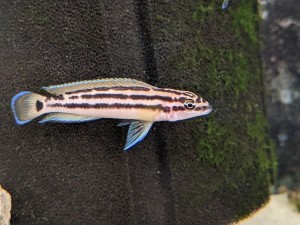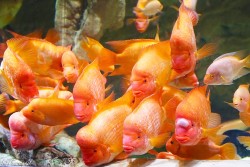Julidochromis ornatus for sale from Eastern Africa; found at depths of 6-15 feet (1.8 to 4.6 meters)
 Julidochromis ornatus, commonly known as the Ornate Julie, is a fascinating species of cichlid native to Lake Tanganyika in East Africa. These cichlids are highly regarded for their intricate and captivating patterns, which adorn their elongated bodies. Ornate Julies typically display a striking combination of black, white, and blue colors, creating a visually stunning appearance that appeals to aquarists specializing in African cichlids.
Julidochromis ornatus, commonly known as the Ornate Julie, is a fascinating species of cichlid native to Lake Tanganyika in East Africa. These cichlids are highly regarded for their intricate and captivating patterns, which adorn their elongated bodies. Ornate Julies typically display a striking combination of black, white, and blue colors, creating a visually stunning appearance that appeals to aquarists specializing in African cichlids.One of the notable characteristics of Julidochromis ornatus is their intriguing behavior. They are known for forming social hierarchies within their groups and establishing territories in rock formations. These territorial behaviors can be captivating to observe in a well-structured aquarium.
To create a suitable habitat for Ornate Julies in captivity, aquarists often provide rocky setups with numerous crevices and hiding spots, mimicking their natural environment. They prefer slightly alkaline water conditions with a pH range of 7.5 to 9.0 and a temperature range of 74-78°F (23-26°C).
Feeding Julidochromis ornatus is relatively straightforward, as they are omnivorous and accept a variety of foods. A balanced diet that includes high-quality cichlid pellets, live or frozen foods like brine shrimp and bloodworms, and occasional plant matter helps maintain their health and vibrant coloration.
Overall, Ornate Julies are prized for their captivating appearance and intriguing social dynamics within the aquarium. They offer aquarists a unique opportunity to appreciate the beauty and behavior of Lake Tanganyika's cichlid diversity in a controlled and visually stunning aquatic setting.
Julidochromis ornatus for sale here when available

Requirements for keeping Julidochromis ornatus
Common Name: Ornate Julie Cichlid
Scientific Name: Julidochromis ornatus
Species: Freshwater fish
Origin: Lake Tanganyika in Africa
Size: Up to 4 inches (10 cm)
Care Level: Moderate
Temperament: Territorial, aggressive
Diet: Carnivore
Minimum Tank Size: 30 gallons
Temperature: 76-82°F
pH Range: 7.8-9.0
Julidochromis ornatus yellow
FAQ's
What is Julidochromis ornatus?
Julidochromis ornatus, also known as the ornate Julie cichlid, is a dwarf freshwater species endemic to Lake Tanganyika in Africa. It is prized for its gray body accented with elegant vertical black stripes. Males also develop extended dorsal and anal fins.
What is their natural habitat?
In the wild, Julidochromis ornatus inhabits rocky shorelines and reefs in the northern end of Lake Tanganyika. They dwell within cracks and crevices, only leaving their shelters to feed.
What does the ornate Julie cichlid eat?
Julidochromis ornatus are carnivores in the wild, feeding on small worms, insect larvae, and crustaceans. In captivity they readily accept foods like brine shrimp, bloodworms, mysis shrimp and quality flakes.
What size tank do they need?
A 30 gallon long aquarium is recommended for Julidochromis ornatus to provide adequate territory and swimming space. The tank should have many rocky hides and be decorated to mimic their native habitat.
Are they suitable for community tanks?
No, ornate Julie cichlids are too aggressive and territorial for community aquariums. They are best kept in a species tank or with one of the slightly larger Julidochromis species.
How large do they grow?
In home aquariums, Julidochromis ornatus typically reaches about 3-4 inches (8-10 cm) in length when fully grown. Well-fed males will be slightly larger than females.
There are currently 6 formally described species in this genus:
Julidochromis dickfeldi
Julidochromis marksmithi
Julidochromis marlieri
Julidochromis ornatus
Julidochromis regani
Julidochromis transcriptus
References
Froese, Rainer and Pauly, Daniel, eds. (2013). "Julidochromis ornatus" in FishBase. February 2013 version.
Bigirimana, C. (2006). "Julidochromis ornatus". IUCN Red List of Threatened Species. 2006: e.T60545A12378250. doi:10.2305/IUCN.UK.2006.RLTS.T60545A12378250.en



